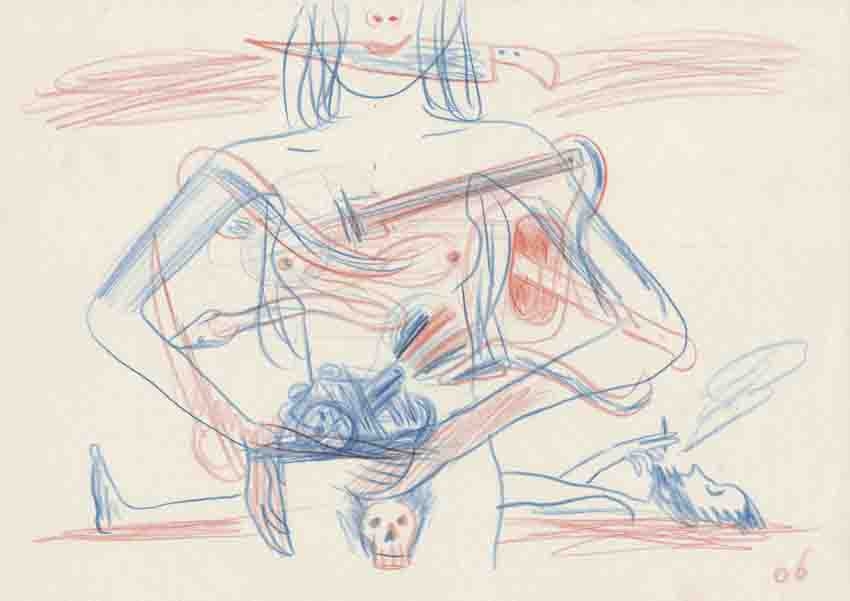‘If you gaze long into an abyss, the abyss will also gaze into you,’ wrote Nietzsche in Beyond Good and Evil (1886). In 2009, Lisbon-based João Maria Gusmão and Pedro Paiva, together with some pataphysical acquaintances (their own definition), founded the Sociedade Internacional de Abissologia (International Society of Abissology) as a ‘platform for production, edition and promotion of Abissological research and associates’. The Sociedade structures the physical/philosophical investigations of the duo, who are spellbound by the obscure paradoxes of reality and its perpetual indiscernibility, in the form of artist books, writings and brief 16mm and 35mm silent films, akin to records of scientific experiments. Gusmão and Paiva often shoot with a high-speed camera (3,000 frames per second), so that the infinitesimal and imperceptible become visible, even if never entirely: everyday objects (eggs, wheels, mirrors, food) become stupefying nanoworlds ruled by movement and entropy, like the infinite atoms and particles that constitute the universe and its black holes – at least, according to the present state of our imperfect knowledge.
The artists’ rich retrospective at Hangar Bicocca (curated by Vicente Todolí), including almost 40 works from 2005 onwards, with 11 new works produced for the occasion, is a hallucinatory walk among shadows, where nature and matter stare back into us, the evidently candid viewers – not much smarter than the family of monkeys trying to figure out how to fish potatoes from a boiling pan (The Soup, 2009) in one of the first films to be encountered. The windowless Hangar is a cavernous postindustrial space naturally plunged into darkness – Milton coming to mind whenever one crosses its threshold: ‘O dark, dark, dark, amid the blaze of noon, / Irrecoverably dark, total eclipse / Without all hope of day!’ – so that cinema feels at home in here. There are no sounds besides that of the purring projectors: the flapping of a parrot’s wings (Glossolalia (‘Good Morning’), 2014), sinking of things into water (Experiment on the Effluvium, 2009), bouncing of ping-pong balls (Cross Eyed Table Tennis, 2014) and chainsawing of a giant tree (Falling Trees, 2014) have to be reconstructed by memory and imagination, like phantom limbs. Perception is limited to enhanced vision.
The itinerary is marked by three camera obscuras, whose floating images are reflected on the walls: the ghost of a train (Before Falling Asleep, a Pre-cortical Image Inside a Moving Train, 2014), a choreography of bicycle wheels turning (Motion of Astronomical Bodies, 2010), a window overlooking the landscape (Camera Inside Camera, 2010). Papagaio (Parrot, 2014), Gusmãao and Paiva’s last film – uncommonly lengthy at 43 minutes and shot in the archipelago of São Tomé and Príncipe, in the Gulf of Guinea – depicts a D’Jambi ritual: people drink, smoke, shiver and shake on the ground when healed and possessed by the spirits of the dead. Black bodies emerge from the night, while the context remains impenetrable: the artists deal with the impossibility of recording any ‘truth’, as well as with the heart of darkness of (Portuguese) colonialism.
Gusmão and Paiva’s Milanese act also generated another apparition, at the new venue of Galleria Zero: the short-lived exhibition Viagem Macaca (Monkey Trip) by painter, draughtsman and illustrator Gonçalo Pena, a close friend of the two artists, who recently edited his eponymous book, released by the Sociedade in collaboration with Mousse. Rhythmically arranged along the walls, Pena’s expressionist sketches on a4 paper called again the senses into play. The pervasiveness of naked bodies having sex, coupled with high and low satiric references to literature, philosophy and politics – Karl Marx mixed with Carl Barks, the cartoonist who invented Scrooge McDuck, for instance – spell out a drastic revolt of the imagination against the order of things. ‘I fuck while you speak,’ proclaims the drawing chosen for the book’s cover. The underbelly of Abissology (as much as that of Pére Ubu) seems full of dark humour.
This article originally appeared in the October 2014 issue
